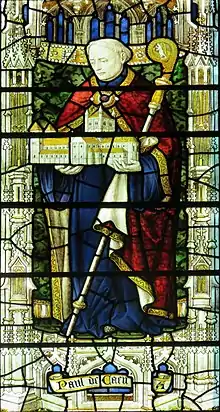Paul of Caen
Paul of Caen[1] was a Norman Benedictine monk who became fourteenth Abbot of St Albans Abbey in 1077, a position he held to 1093.[2][3] He was a nephew of Archbishop Lanfranc.[4]

Paul of Caen on stained glass windows of Cathedral St-Albans.
Paul, former monk of the Saint-Étienne abbey in Caen,[5] was an energetic builder at the Abbey,[6] having materials from the ruins of Roman Verulamium, collected by earlier abbots Ealdred and Ealmer, to work with.[7] He also took a firm line with older reverences, disregarding some Anglo-Saxon relics and tombs,[8] and allowing the incorporation of older religious stonework into foundations, thus paradoxically ensuring their preservation for archaeology.[9] He encouraged the transcription of manuscripts.[10][11]
Notes
- Paul of St Albans, Paul de Caen.
- "St Albans abbey: History." A History of the County of Hertford: Vol. 2. (William Page, ed.) London: Victoria County History, 1908. 483-488. British History Online. Web. 10 June 2018.
- David Knowles, The Monastic Order in England (2nd edition 1963), p.96.
- (in French) Célestin Hippeau, L'Abbaye de Saint-Étienne de Caen, 1066-1790, Caen, A. Hardel, 1855, p.28
- St Albans Abbey
- Knowles. pp.118-9.
- "CINOA: An Important Anglo Danish carved sandstone pillar slab , School of Bakewell". Archived from the original on 2007-03-12. Retrieved 2007-04-12.
- Gesta Abbatum Monasterii Sancti Albani, ed. H. T. Riley, 3 vols. (London, 1867) vol. 1, pp 51-66
- R. M. Thomson, Manuscripts from St Albans Abbey 1066-1235, 2 vols. (Woodbridge, 1985), vol. 1, pp 11-77
This article is issued from Wikipedia. The text is licensed under Creative Commons - Attribution - Sharealike. Additional terms may apply for the media files.